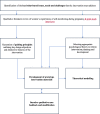Intervention planning and modification of the BUMP intervention: a digital intervention for the early detection of raised blood pressure in pregnancy
- PMID: 31890265
- PMCID: PMC6925434
- DOI: 10.1186/s40814-019-0537-z
Intervention planning and modification of the BUMP intervention: a digital intervention for the early detection of raised blood pressure in pregnancy
Abstract
Background: Hypertensive disorders in pregnancy, particularly pre-eclampsia, pose a substantial health risk for both maternal and foetal outcomes. The BUMP (Blood Pressure Self-Monitoring in Pregnancy) interventions are being tested in a trial. They aim to facilitate the early detection of raised blood pressure through self-monitoring. This article outlines how the self-monitoring interventions in the BUMP trial were developed and modified using the person-based approach to promote engagement and adherence.
Methods: Key behavioural challenges associated with blood pressure self-monitoring in pregnancy were identified through synthesising qualitative pilot data and existing evidence, which informed guiding principles for the development process. Social cognitive theory was identified as an appropriate theoretical framework. A testable logic model was developed to illustrate the hypothesised processes of change associated with the intervention. Iterative qualitative feedback from women and staff informed modifications to the participant materials.
Results: The evidence synthesis suggested women face challenges integrating self-monitoring into their lives and that adherence is challenging at certain time points in pregnancy (for example, starting maternity leave). Intervention modification included strategies to address adherence but also focussed on modifying outcome expectancies, by providing messages explaining pre-eclampsia and outlining the potential benefits of self-monitoring.
Conclusions: With an in-depth understanding of the target population, several methods and approaches to plan and develop interventions specifically relevant to pregnant women were successfully integrated, to address barriers to behaviour change while ensuring they are easy to engage with, persuasive and acceptable.
Keywords: Digital intervention; Hypertension; Intervention planning; Person-based approach; Pre-eclampsia; Pregnancy.
© The Author(s). 2019.
Conflict of interest statement
Competing interestsRM has received blood pressure monitoring equipment for research studies from Omron and Lloyds Pharmacy. No other author has a conflict.
Figures




Similar articles
-
Blood pressure self-monitoring in pregnancy (BuMP) feasibility study; a qualitative analysis of women's experiences of self-monitoring.BMC Pregnancy Childbirth. 2017 Dec 19;17(1):427. doi: 10.1186/s12884-017-1592-1. BMC Pregnancy Childbirth. 2017. PMID: 29258469 Free PMC article.
-
Intervention development and optimisation of a multi-component digital intervention for the monitoring and management of hypertensive pregnancy: the My Pregnancy Care Intervention.Pilot Feasibility Stud. 2024 Nov 12;10(1):139. doi: 10.1186/s40814-024-01562-9. Pilot Feasibility Stud. 2024. PMID: 39533431 Free PMC article.
-
Self-monitoring blood pressure in pregnancy: evaluation of women's experiences of the BUMP trials.BMC Pregnancy Childbirth. 2024 Nov 28;24(1):800. doi: 10.1186/s12884-024-06972-4. BMC Pregnancy Childbirth. 2024. PMID: 39604875 Free PMC article.
-
Digital interventions for hypertension and asthma to support patient self-management in primary care: the DIPSS research programme including two RCTs [Internet].Southampton (UK): National Institute for Health and Care Research; 2022 Dec. Southampton (UK): National Institute for Health and Care Research; 2022 Dec. PMID: 36538606 Free Books & Documents. Review.
-
Folic acid supplementation and malaria susceptibility and severity among people taking antifolate antimalarial drugs in endemic areas.Cochrane Database Syst Rev. 2022 Feb 1;2(2022):CD014217. doi: 10.1002/14651858.CD014217. Cochrane Database Syst Rev. 2022. PMID: 36321557 Free PMC article.
Cited by
-
Planning and developing a web-based intervention for active surveillance in prostate cancer: an integrated self-care programme for managing psychological distress.Pilot Feasibility Stud. 2022 Aug 9;8(1):175. doi: 10.1186/s40814-022-01124-x. Pilot Feasibility Stud. 2022. PMID: 35945609 Free PMC article.
-
Patients' and Providers' Perspectives on and Needs of Telemonitoring to Support Clinical Management and Self-care of People at High Risk for Preeclampsia: Qualitative Study.JMIR Hum Factors. 2022 Feb 7;9(1):e32545. doi: 10.2196/32545. JMIR Hum Factors. 2022. PMID: 35129445 Free PMC article.
-
A Digital Lifestyle App for Hypertension During Pregnancy: Mixed Methods Intervention Development Study Using the Person-Based Approach.JMIR Form Res. 2025 Jul 18;9:e68927. doi: 10.2196/68927. JMIR Form Res. 2025. PMID: 40704687 Free PMC article.
-
Effect of Self-monitoring of Blood Pressure on Diagnosis of Hypertension During Higher-Risk Pregnancy: The BUMP 1 Randomized Clinical Trial.JAMA. 2022 May 3;327(17):1656-1665. doi: 10.1001/jama.2022.4712. JAMA. 2022. PMID: 35503346 Free PMC article. Clinical Trial.
-
Effect of Self-monitoring of Blood Pressure on Blood Pressure Control in Pregnant Individuals With Chronic or Gestational Hypertension: The BUMP 2 Randomized Clinical Trial.JAMA. 2022 May 3;327(17):1666-1678. doi: 10.1001/jama.2022.4726. JAMA. 2022. PMID: 35503345 Free PMC article. Clinical Trial.
References
Grants and funding
LinkOut - more resources
Full Text Sources

